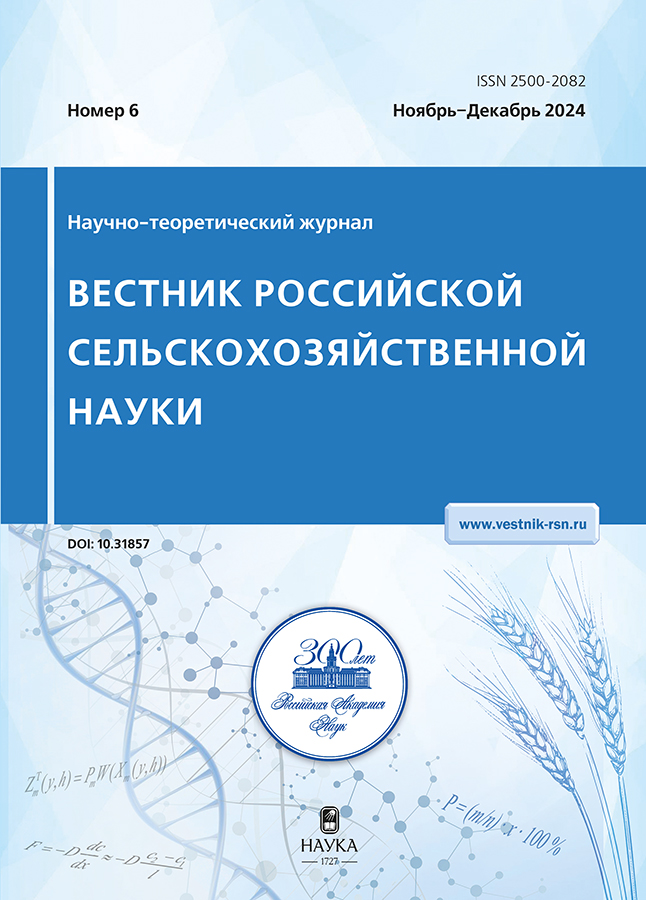Сравнение методов экстракции ДНК из личинок Hermetia illucens
- Авторы: Сутула Г.И.1, Лоскутов С.И.1, Ситнов В.Ю.1
-
Учреждения:
- Всероссийский научно-исследовательский институт пищевых добавок – филиал федерального государственного бюджетного научного учреждения Федеральный научный центр пищевых систем имени В.М. Горбатова РАН
- Выпуск: № 6 (2024)
- Страницы: 78-82
- Раздел: Новые технологии
- URL: https://vietnamjournal.ru/2500-2082/article/view/659230
- DOI: https://doi.org/10.31857/S2500208224060171
- EDN: https://elibrary.ru/WSVEOY
- ID: 659230
Цитировать
Полный текст
Аннотация
Муха черная львинка (Hermetia illucens) – перспективный источник корма для животных из-за высокого содержания белка и жира. В 2023 году решением Правительства РФ она была включена в перечень сельскохозяйственной продукции. Но в отечественной литературе очень мало данных по применению молекулярно-генетических методов в отношении черной львинки и практически полностью отсутствует информация о способах экстракции из нее ДНК. Цель исследования – сравнение эффективности существующих методов выделения ДНК и их адаптация для работы с личинками Hermetia illucens. Опробованы несколько способов экстракции ДНК, основывающихся на разных лизирующих (SDS, тиоцианат гуанидина, CTAB) и хелатирующих (EDTA) агентах, а также продолжительностях лизиса – 1, 2 и 3 ч. Установлено, что наибольшая концентрация ДНК (750 нг/ мкл) достигается CTAB-методом, но в данном случае необходима дополнительная очистка. Комбинированное действие SDS и высоких концентраций EDTA приводит к меньшему выходу ДНК (50 нг/мкл), но не требует дополнительной очистки. Впервые применен метод, основанный на тиоцианате гуанидина, который оказался достаточно релевантным для данного объекта изучения. Все вышеперечисленные методы приводили к сопоставимому или более высокому выходу ДНК, по сравнению с коммерческим набором ГМО-СОРБ-Б. Увеличение длительности лизиса до 3 ч при использовании методов, основанных на тиоцианате гуанидина и CTAB, повышает концентрацию ДНК.
Ключевые слова
Полный текст
Об авторах
Глеб Игоревич Сутула
Всероссийский научно-исследовательский институт пищевых добавок – филиал федерального государственного бюджетного научного учреждения Федеральный научный центр пищевых систем имени В.М. Горбатова РАН
Автор, ответственный за переписку.
Email: capitals2016@yandex.ru
ORCID iD: 0009-0002-2781-9035
младший научный сотрудник
Россия, Санкт-ПетербургСвятослав Игоревич Лоскутов
Всероссийский научно-исследовательский институт пищевых добавок – филиал федерального государственного бюджетного научного учреждения Федеральный научный центр пищевых систем имени В.М. Горбатова РАН
Email: capitals2016@yandex.ru
ORCID iD: 0000-0001-9377-5515
кандидат сельскохозяйственных наук, старший научный сотрудник
Россия, Санкт-ПетербургВениамин Юрьевич Ситнов
Всероссийский научно-исследовательский институт пищевых добавок – филиал федерального государственного бюджетного научного учреждения Федеральный научный центр пищевых систем имени В.М. Горбатова РАН
Email: capitals2016@yandex.ru
ORCID iD: 0000-0003-1927-1997
директор ВНИИПД
Россия, Санкт-ПетербургСписок литературы
- Calderón-Cortés N., Quesada M., Cano-Camacho H., Zavala-Páramo G. A Simple and Rapid Method for DNA Isolation from Xylophagous Insects // International Journal of Molecular Sciences. 2010. Vol. 11(12). P. 5056–5064. https://doi.org/10.3390/ijms11125056
- Chen M., Zhu Y., Tao J., Luo Y. Methodological comparison of DNA extraction from Holcocerrus hippophaecolus (Lepidoptera: Cossidae) for AFLP analysis // Forestry Studies in China. 2008. Vol. 10(3). P. 189–192. https://doi.org/10.1007/s11632-008-0035-5
- Dave N., Joshi T. A Concise Review on Surfactants and Its Significance // International Journal of Applied Chemistry. 2017. Vol. 13(3). P. 663–672. https://doi.org/10.37622/IJAC/13.3.2017.663-672
- Esser K.-H., Marx W.H., Lisowsky T. MaxXbond: first regeneration system for DNA binding silica matrices // Nature Methods. 2006. Vol. 3(1). https://doi.org/ 10.1038/nmeth845
- Gautam A. Phenol-Chloroform DNA Isolation Method. Springer International Publishing. 2022. P. 33–39. https://doi.org/10.1007/978-3-030-94230-4_3
- Green T.R., Popa R. Enhanced Ammonia Content in Compost Leachate Processed by Black Soldier Fly Larvae // Applied Biochemistry and Biotechnology. 2012. Vol. 166(6). P. 1381–1387. https://doi.org/10.1007/s12010-011-9530-6
- Sadykova E.O., Tyshko N.V., Nikitin N.S. et al. Monitoring methods for novel insect-derived food: the PCR protocol for the detection and identification of Hermetia Illucens insects based on the HEI-COI probe and primer system // Problems of Nutrition. 2023. Vol. 92(1). P. 36–44. https://doi.org/ 10.33029/0042-8833-2023-92-1-36-44
- Shehadul Islam M., Aryasomayajula A., Selvaganapathy P. A Review on Macroscale and Microscale Cell Lysis Methods // Micromachines (Basel). 2017. Vol. 8(3) P. 83. https://doi.org/10.3390/mi8030083
- Suganthi M., Abirami G., Jayanthi M. et al. A method for DNA extraction and molecular identification of Aphids // MethodsX. 2023. Vol. 10. P. 102100. https://doi.org/10.1016/j.mex.2023.102100
- Tan S.C., Yiap B.C. DNA, RNA, and Protein Extraction: The Past and The Present // Journal of Biomedicine and Biotechnology. 2009. Vol. 2009. P. 1–10. https://doi.org/10.1155/2009/574398
- Zheng L., Hou Y., Li W. et al. Biodiesel production from rice straw and restaurant waste employing black soldier fly assisted by microbes // Energy. 2012. Vol. 47(1). P. 225–229. https://doi.org/10.1016/j.energy.2012.09.006
Дополнительные файлы















